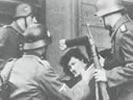Eye For Film >> Movies >> Rome, Open City (1945) DVD Review

The DVD is a little thin when it comes to the extras, with just a recent TV documentary about what it was like to be a child actor in war-torn Rome as the only supplement, alongside the obligatory scene-by-scene selection and English subtitles.
The documentary is a 45-minute, made-for-television Italian programme, which is primarily a journey back to the locations and spirit of the film with Vito Annichiarico, who was excellent as a child actor, playing the son of Pina (Anna Magnani). It is, of course, a very emotional journey and the actor is at times overcome by nostalgia when visiting some of the locations that he had not been back to in 60 years.

Vito recalls the filming and his role as the young boy and the fate of his mother in the film. Indeed, as the war was just ending, this was more than just acting, in that we could understand these actors were playing themselves, such was the immediacy of everything around them. In fact, filming began only two months after the liberation of Rome and Rossellini was mainly using film stock that was given to him by a photographer.
Despite being the only additional feature on the DVD, it is very worthwhile because it is so compelling, if a little non-dramatic, considering the legendary film it is about. It is also cheaply made, yet still charming and interesting to watch. In fact, the calmness and leisurely pace of the documentary makes a good contrast to the intensity of the main feature and Vito is an excellent tour guide for the film, although the attention and subject diverts more to himself near the end, as he explains how (and why) he drifted away from acting as a career.
Those who may want to see the documentary before, or as an introduction to the main feature, shouldn't expect too much of an insight into the story of Rome, Open City. It comes as a surprise that no critic, or film historian, gives us their guide to the film and how, or why, it is considered a masterpiece. There is some archive footage of interviews and voice-overs, but that's as close as we get to the film itself. Therefore, we should only enjoy this as a companion piece.
The end of the documentary is touching, as some of those who were involved originally, who are still alive, have dinner together and seem genuinely humble, yet proud of being part of something that was not only a classic, but also an important document about the most severe period in world history.
Read our separate review of Children Of Rome, Open City.
Reviewed on: 09 Jul 2005

















